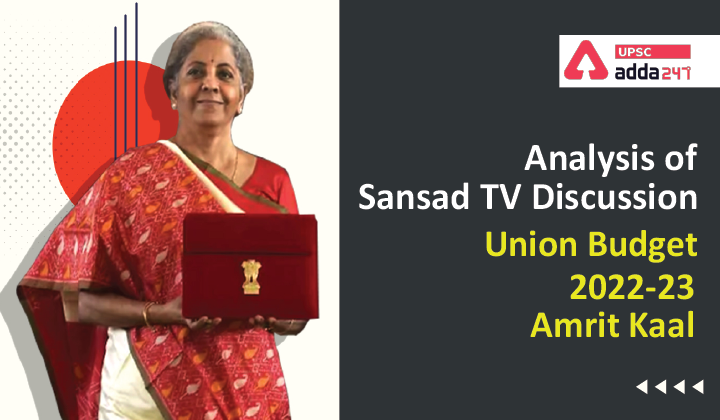Union Budget 2022-23: ”Amrit Kaal”
Relevance
”GS 3: Government Budgeting”
Introduction
- In her Budget speech, India’s finance minister Nirmala Sitharaman said the Budget seeks to lay the foundation to steer the economy over “Amrit Kaal” of the next 25 years from India at 75 to India at 100 while continuing to build on the vision of Budget.
- In a sense, India’s finance minister was pointing towards the long-term effect of the Budget as a vision statement.
Where Does the Term Amrit Kaal Originate From?
- The term comes from Vedic astrology.
- Amrit Kaal is the critical time when the gates of greater pleasure open for the inhuman, angels and human beings.
- Amrit Kaal is considered the best and most auspicious time to start new work.
When was the word first used by the present regime?
- The word was used by Prime Minister Narendra Modi on 15 August for the first time while unveiling the roadmap for the next 25 years.
- He said that the purpose of Amrit Kaal is to better the lives of citizens, lessen the development divide between villages and cities, reduce government interference in people’s lives, and have the latest technology.
- Starting from here, the journey of the next 25 years is the Amrit Kaal of a new India. The fulfilment of our resolutions in this Amrit Kaal will take us till 100 years of independence.
The vision of Amrit Kaal
- All-inclusive Welfare focus wherein complementing Macro Economic level growth focus with the Micro Economic level;
- Promotion of digital economy and Fintech, technology-enabled development, Energy Transition and Climate Action; and
- Reliance on virtuous cycle from private investment with Public Capital Investment in order to crowd-in private investment.
4 Priorities of Futuristic and Holistic Budget
- PM GatiShakti;
- Inclusive Development;
- Productivity enhancement & investment, Sunrise opportunities, Energy transition and Climate action; and
- Financing of investments
What will be the approach to achieve long term goals?
- The Budget lays a parallel track of a blueprint for the Amrit Kaal, which is futuristic and inclusive, directly benefiting youth, women, farmers, the Scheduled Castes and the Scheduled Tribes.
- The approach is powered by clean energy and Sabka Prayas(everyone’s effort together leading to huge job and entrepreneurial opportunities for all, especially the youth.
- It involved seven engines – roads, railways, airports, mass transport, ports, waterways and logistics infrastructure which will be supported by energy transmission, IT, water, sewerage and social infrastructure.
- The plan is based on “seamless multimodal connectivity and logistics efficiency”. It will also include infrastructure developed by state governments, according to the “Gati Shakti National Master Plan”.
- According to the plan, the key focus would be planning, financing and finding innovative ways through technology and fast implementation.
What is PM GatiShakti?
- Prime Minister Narendra Modi announced PM Gati Shakti on 15 August it was later launched on 14 October.
- Touted as the “National Master Plan for World-Class Modern Infrastructure”, PM Gati Shakti is driven by seven engines, namely Roads, Railways, Airports, Ports, Mass Transport, Waterways, and Logistics Infrastructure.
- The government will formulate the PM Gati Shakti master plan for expressways in the financial year 2022-23 to facilitate the faster movement of people and goods.
- The National Highways network will be expanded by 25,000 km in 2022-23 and Rs 20,000 crore will be mobilised.
- As part of the master plan, contracts for the implementation of Multimodal Logistics Parks at four locations through PPP mode will be awarded in 2022-23.
- In Railways, the ‘One Station-One Product’ concept will be popularised to help local businesses and supply chains.
Conclusion
The Union Budget 2022-23 has stayed true to the long-term goal of complementing macro-growth with a focus on infrastructure digital economy and fintech, tech-enabled development, energy transition and climate action.



 TSPSC Group 1 Question Paper 2024, Downl...
TSPSC Group 1 Question Paper 2024, Downl...
 TSPSC Group 1 Answer key 2024 Out, Downl...
TSPSC Group 1 Answer key 2024 Out, Downl...
 UPSC Prelims 2024 Question Paper, Downlo...
UPSC Prelims 2024 Question Paper, Downlo...





